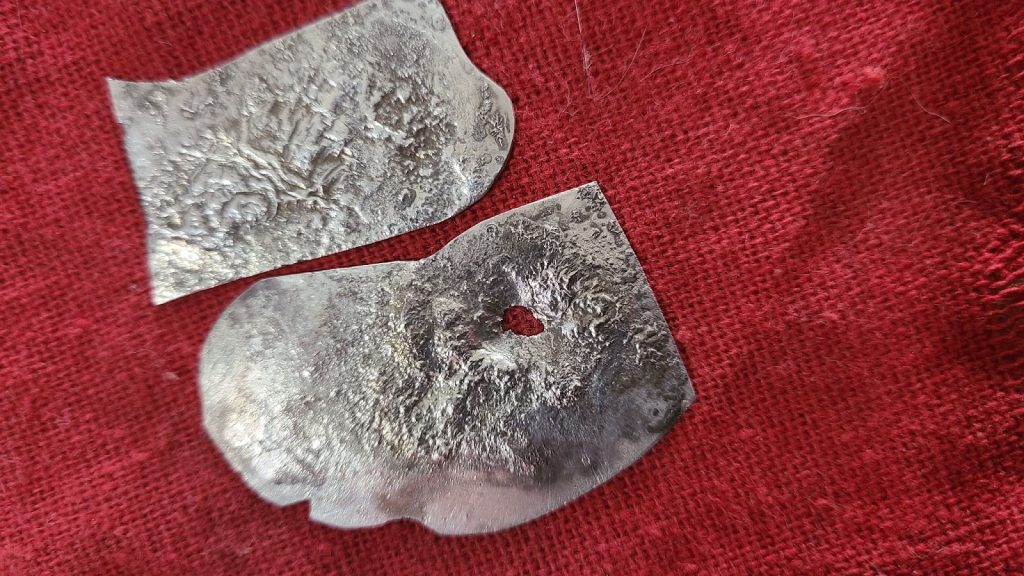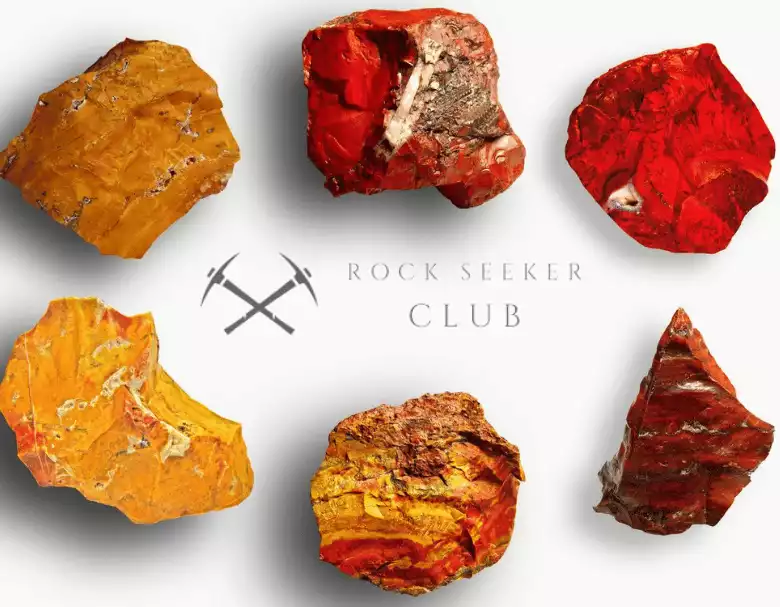Reticulation is one of the more interesting surface treatments we can give to silver. Even better, if you have the basics for silverwork in your home then you don’t even need any specialized equipment to add it. It provides an organic, one-of-a-kind texture that provides a lot of visual interest to a surface.
But how is it done? When do you do it when you’re working on a piece? Well, follow along with me, and let’s find out!
What is Silver Reticulation?
Reticulation is a surface treatment for metals that is created by using a ton of heat to melt the surface of the specially prepared metal and then allow it to flow before you pull the flame off. The texture provided is best described as “wrinkled.”
It’s done by carefully separating the layers via repeated depletion gilding and then taking advantage of the difference in melting points. The interior then melts before the exterior, creating a wrinkled texture as the surface deforms due to thermal shock.
It’s less complicated than it sounds.
I’ll be demonstrating this technique using a basic piece of sterling silver made from some scraps in my shop. Reticulation can be done using sterling silver or with reticulation silver. Fine silver need not apply, for reasons we’ll see in a moment.
Reticulation is an 80/20 silver/copper blend that is available from specialty sources. It produces a better texture than sterling but brings its own problems. Namely, it’s more porous and thus harder to solder properly. It’s often sold as “pre-reticulation” silver.
Copper oxides play a key role in reticulation, so most alloys with copper can go through the process. That includes base metals like brass or bronze, as well as materials like 14K and 18K gold and rose gold. Some alloys will have more difficulty attached. In particular, white gold has problems with reticulation in addition to the other caveats of working with the material.
We’re going to exploit a few silver working processes to make this work, but the big one that you need to know about is depletion gilding.
In other words, we form a layer of fine silver on top of the alloy through heat and acid. It’s not as technical as it sounds, but it is a bit time-consuming. It’s not hard to achieve in the shop and you can use a homemade pickle as your acid. Vinegar or citric acid will do just fine.
But the essential bit is this: reticulation is a surface treatment created through the removal of copper in the surface of an alloy and exploiting thermal expansion/retraction to change the surface. The end result is similar to just melting the surface of the piece, without affecting the core.
Reticulated metal becomes brittle and forming ranges from problematic to impossible once it’s done. Make sure that you place it correctly in your order of operations, attempting something like bending a flat strip of reticulated silver into a ring band can result in a structural failure.
In other words, reticulated silver breaks easily. Try to finish all shaping and bending operations before you reticulate the silver.
What Do I Need to Reticulate Silver
You don’t need much, even the most basic setup should be able to handle silver reticulation.
- Torch- Reasonably sized is best. I used my normal butane torch for the demonstration, but hotter torches are required for larger pieces.
- Pickle- Any pickle works. If you have a way to keep it heated, like a crockpot, then you’ll be able to do things a little bit faster.
- Cross-lock Tweezers- For picking up the silver while it’s heated.
- Copper or Wooden Tongs- To remove the metal from the pickle without copper plating.
- Torch Safe Surface- Whatever you normally use to solder will work fine. Charcoal is not preferred for this process since it protects the metal from oxidation but it’s not a deal-breaker.
- Silver- Gauges between 18-26 work the best. Any forming processes should be done by this point. That includes bending rings or cuffs, doming pieces for pendants, and any other serious forming work. Any soldering should take place after reticulation. Plan accordingly.
And… that’s really it.
Well, except for the normal PPE. Goggles are recommended when working with pickle since a splash can go around the lenses.
Safety Note: Quenching in your pickle saves time but it can release acidic compounds into the air. I’ve heard various opinions on it and assessed the level of risk I’m comfortable with. If you’re not comfortable with quenching in pickle, then you can quench it in water and transfer it to the pickle afterward. It’ll just take a few minutes longer.
So, with your things gathered… let’s get to the good stuff!
1. Prepare the Metal
Set your shaped piece of metal on a soldering block or other heat-safe surface. The surface should be clean, sand off any oxidation from annealing or other heated processes first.
Double-check that you won’t need to seriously bend the piece again. Reticulation will make the silver rather brittle.
Now, you’re going to use your torch to heat the piece up to a dull red temperature, roughly annealing temperature. If you’ve ever managed to anneal silver and end up with just the dull grey layer on top before pickling, you know what to do. That’s a relatively even distribution of copper oxidation across the surface.
Once the metal has been heated to that temperature, stick it in the pickle. Wait until the surface is entirely white again and pull it out of the pickle. This usually takes 3-4 minutes in a heated pickle jar and will take longer in a cold one. If you can’t see the piece then pull it with your copper or wooden tongs every five minutes or so to check on it.
The white, sometimes powdery, finish on pickled sterling silver is fine silver since the copper oxides dissolve into the pickle. You can clean it up quickly with a brash (not steel) brush or a silver polishing cloth.
That’s one cycle.
Repeat this for at least 7 cycles, preferably 10-15.
The basic idea is to torch all the copper that’s permeable by the acid and get it out of the metal. This will let us take advantage of the difference between the core of the material and the outer layers.
I am not exaggerating when I say the minimum amount of cycles is 7. If you insist and forge ahead with just a few cycles the end results will be very disappointing.
Learn from my mistakes.
2. Reticulate the Prepared Metal
Reticulating the piece can be done once you have a sufficiently thick layer of fine silver. While the heat/acid cycles are time-consuming, the more the better. You’ll know when it’s good to go because the silver will stop changing color.
Once you’re satisfied with the top layer, you can now begin the reticulation process.
Pre-heat the soldering surface if you’re not using a screen. Just run the torch over your brick or charcoal until it’s hot, this will help you get to the right temperature faster.
Heat the metal until it’s reached a red temperature across the entire surface.
Now comes the fun part.
You’ll be using localized heat in excess of the red temperature to create the texture. The idea is pretty simple: fine silver has a higher melting point than sterling silver. You’re attempting to make the sterling in the center melt… while not melting the fine silver on the surface.
You’ll want to get the piece to a bright orange temperature, focusing heat from there is how you get the process rolling. Don’t wait for the ideal texture to show up, cooling furthers the texture, and melting the piece on accident isn’t ideal.
It’s not as hard as it sounds, but you can melt smaller pieces of silver easily while doing this. You may also punch a hole in it if you’re not careful, but I feel like it just adds to the organic texture sometimes.
The actual wrinkling and texture forming comes from the mismatch in matter states. As the metal in the center cools and becomes a solid, it causes the surface to warp and wrinkle.
Controlling the texture is… pretty much impossible. I’ve yet to see anyone who can replicate a texture twice, although their textures may end up with some distinctive features like swirls or particularly sharp ridges.
With the metal at temperature, you can now use your torch to spot-heat areas and then move on to another area. Observe the results and continue until the piece is finished to your satisfaction.
3. Finish Your Piece

With the silver reticulated, all you have to do is finish your piece!
Reticulated silver will act a bit differently than normal sterling silver. You should be aware of these before you go and run solder all over your time-consuming reticulated silver.
Soldering can become problematic, depending on the level of reticulation. Stripping the copper from the fine silver and then causing it to bend also leaves the metal a bit porous. You’re not dealing with excellent grain structure by the time the piece is done being prepared and reticulated.
There’s a pretty simple solution to make life easier: burnish any bits of reticulated silver that come into contact with the solder joint. This will give you a much better surface to use. You may also want to consider using a bit more solder than normal.
Forming processes become very hard with reticulated silver. After all, we just destroyed the grain structure of the silver to get this effect. Still, the silver will be annealed and small bits of forming can take place.
By which I mean you can completely close a ring or make minor adjustments on a cuff, if you reticulated the silver before you did the major bending… you may want to use that bit of reticulated silver for something else.
Oxidation will take a bit longer than normal since the surface is fine silver. I’ll often oxidize reticulated pieces to make the texture look deeper while polishing the high points. It’ll still oxidize, even if you’re just using a liver of sulfur solution.
Other than that, you’re good to go. The metal can be cut, drilled, polished, and colored like any other piece of silver.
It’s a time-consuming process, but it results in an organic and one-of-a-kind texture. That’s a lot for a technique you can do with minimal tools.
- Online rock and mineral club for collectors of all levels!
- Find community with like-minded rock and mineral enthusiasts.
- Monthly Giveaways!
- Free Access to Entire Digital Library of Products (annual memberships)


